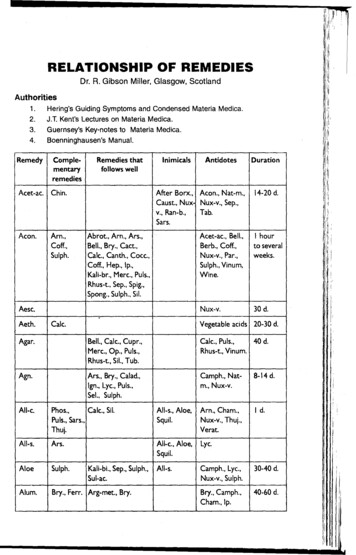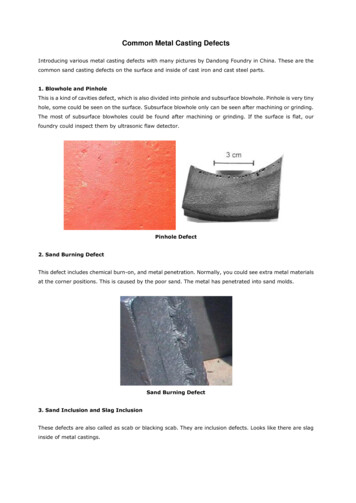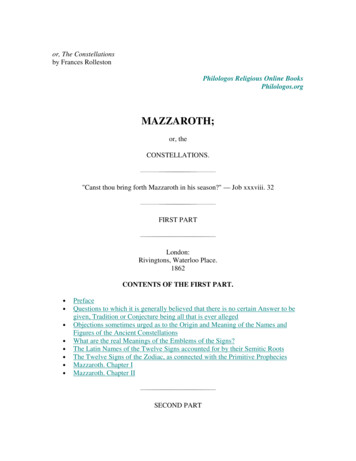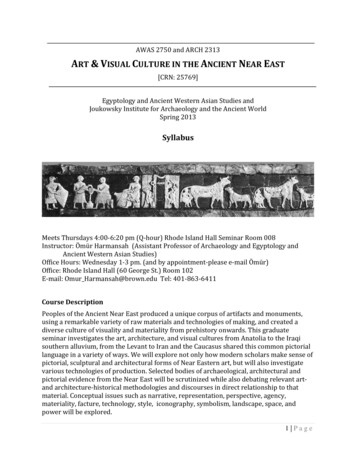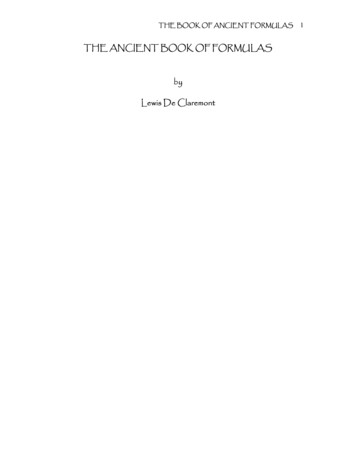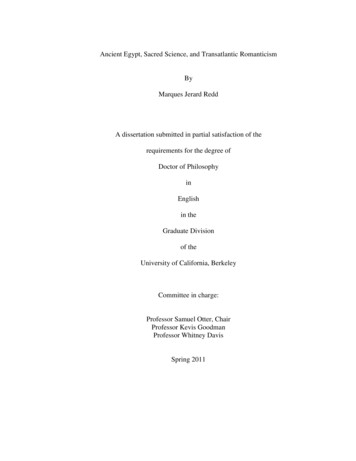
Transcription
ANCIENT REMEDIES FOR A MODERN YOU:AN INTRODUCTION TO AYURVEDAby Premal Patel, MD
Table of Contents23Chapter 1: What is Ayurveda?6Chapter 2: Prakriti—Your Constitution8Chapter 3: Vikiriti—Your Imbalances9Chapter 4: How Lifestyle Influences Dosha Balance10Chapter 5: The Secret to Great Health—Managing Doshas to Maintain Balance16Glossary800.953.6424 BANYANBOTANICALS.COMAncient yet timeless, Ayurveda gives us the means ofattaining and maintaining our own optimal health andwell-being. Its benefits have been proven over centuriesof use, and its methodologies are as applicable today inthe West as they were thousands of years ago in India.Ayurveda recognizes that each person is unique andoffers a customized approach to wellness. This bookletoutlines the basics of Ayurveda, and explains how youcan begin to use this science of health for yourself.
Chapter 1: What is Ayurveda?Ayurveda is considered one of the world’s oldest healingsciences, originating in India at least 5,000 years ago. Itsname is a Sanskrit word that literally translates as “thewisdom of life” or “the knowledge of longevity” (it is acompound of ãyus, meaning life or longevity, and veda,meaning deep knowledge or wisdom). In accordance withthis definition, Ayurveda views health as much more thanthe absence of disease.Health, from an Ayurvedic perspective, is defined as agracious, tranquil, content, joyous, bright, and clear state ofthe body, senses, mind, and spirit, including the balancedstate of one’s natural constitution, all bodily tissues, thedigestive capacities, and waste excretion. What a mouthful!Simply put, health is achieved when you are aligned withyour own natural and unique state of balance.How is Your Health Unique?The key to Ayurvedic wellness and healing is theknowledge that health is not a “one size fits all” proposition.One must understand the unique nature of each personand situation, taking into account the individual, theseason, the geography, and so on.Each person has a constitution that is specific to him or her,and movement away from that constitution creates healthimbalances; if such imbalances are not addressed, diseasemay develop. So, the early signs of imbalance serve as awakeup call to make gentle and natural shifts in behavior toreturn to balance—such as adjusting diet, modifying dailyactivities, and taking herbal remedies for a time.The Five Elements That Transform OurUnderstanding of HealthAyurveda arises from a tradition that describes the entirephysical world—including man—in terms of five elements:space, air, fire, water, and earth. These five elements canmost accurately be thought of as energetic patterns ratherthan as purely physical substances, and each has particularqualities. To help make sense of this, consider how theseelements manifest in the natural world: Earth is cold, heavy, solid, stable, and dry.This element is exemplified by dirt. Water is cold, mobile, heavy, soft, andliquid. Think of the ocean. Fire is hot, subtle, mobile, dry, and sharp. Itsclearest manifestation in nature is the sun,which provides warmth to the earth and sky. Space, as in the sky, is vast, cold, light,and clear. It enables all other things tohave a place to take form and exist. Air is dry, cold, rough, and full of motion. Tounderstand these qualities, think of what it’slike to be whipped by an aggressive wind.These five elements clearly manifest individually in thenatural world. But even more profoundly, they all exist at alltimes in all things—including in the body—and each has itsparticular role to play.To understand how imbalances occur, and what to do aboutthem, we can look to the following fundamental concepts ofAyurveda.800.953.6424 BANYANBOTANICALS.COM3
Chapter 1: What is Ayurveda? (cont’d)For example, let’s look at the body’s digestive system: Earth rules the actual structure andsolidity of the digestive tract. Water rules the liquid, fluid quality ofthe digestive juices and acids. Fire rules the heat and digestive enzymesinvolved in the metabolic process. Space pervades the whole process,including the space within each cell. Air rules the peristaltic movement of thenutrients through the digestive tract.In fact, each and every cell of the body is made up of allfive elements.The Three Doshas That Will Change the Way YouSee YourselfThe five elements combine in various ways to form threeconstitutional principles, known in Ayurveda as doshas.These are: Vata, comprised of air and space. Pitta, comprised of fire and water. Kapha, comprised of earth and water.To understand these principles at their core, it is usefulto think of the different qualities of the elements thatcreate them.4800.953.6424 BANYANBOTANICALS.COMVataComposed of air and space, vata is dry, light,cold, rough, subtle/pervasive, mobile, and clear. As such,vata regulates the principle of movement. Any bodilymotion—chewing, swallowing, nerve impulses, breathing,muscle movements, thinking, peristalsis, bowel movements,urination, menstruation—requires balanced vata. Whenvata is out of balance, any number of these movements maybe deleteriously affected.PittaPitta brings forth the qualities of fire and water.It is sharp, penetrating, hot, light, liquid, mobile,and oily. Pitta’s domain is the principal of transformation.Just as fire transforms anything it touches, pitta is inplay any time the body converts or processes something.So pitta oversees digestion, metabolism, temperaturemaintenance, sensory perception, and comprehension.Imbalanced pitta can lead to sharpness and inflammationin these areas in particular.KaphaKapha, composed of earth and water, is heavy,cold, dull, oily, smooth, dense, soft, static, liquid, cloudy,hard, and gross (in the sense of dense or thick). As kaphagoverns stability and structure, it forms the substance ofthe human body, from the skeleton to various organs to thefatty molecules (lipids) that support the body. An excess ofkapha leads to an overabundance of density, heaviness, andexcess in the body.Once you put on the lenses of Ayurveda and see things interms of vata, pitta, kapha, and combinations thereof, thewhole world comes alive in a new way. Look at the worldaround you! The doshas take form in endlessly interestingways (see Table 1 for examples).
Chapter 1: What is Ayurveda? (cont’d)Table 1Examples of Vata, Pitta, and Kapha Vata: A tornado, a hummingbird, and wind energy Pitta: A volcanic eruption, a tiger, and solar power Kapha: An earthquake, an elephant, and geothermal powerVATAPITTAKAPHA800.953.6424 BANYANBOTANICALS.COM5
Chapter 2: Prakriti—Your ConstitutionThe Big Question: What’s Your Dosha?The three doshas, representing the five elements, arepresent in everyone to some degree. They are all anecessary and integral part of the body. But each of us isborn with our own unique dosha balance, known as ourprakriti. We are truly individuals—even twins are bornwith differences.Some people are dominant in one principle—either vata,pitta, or kapha. While others have two doshas that come tothe fore, though one of the two is often primary (even morepresent). Still others possess a fairly equal balance of eachvata, pitta, and kapha (this is called tri-doshic), though thisis rare.So what’s your prakriti? Knowing this gives you the key tousing Ayurveda effectively for yourself.Determining your prakriti—your fundamental doshabalance—requires an assessment of your most natural state.Consider your physical structure as well as mental andemotional tendencies. Remember to think of what is mostnatural to you, rather than what you’re like when you arestressed or ill.The features (facial features, limbs, fingers, etc.) arelong, slim, or narrow, and the hair is thin, wiry, or curly. Digestion: The appetite and digestion are oftenvariable, going up and down, yet often leantowards “eating like a bird” and constipation. Personality: A vata person tends to be creative,be able to “go with the flow” and think abstractly,and often has rapid speech with a thin, raspy,high-pitched, or crackly voice. Vata predominantpeople are also prone to fear and anxiety, andhave trouble focusing on one thing at a time.Pitta CharacteristicsA pitta predominant person displays the following traits. Physique: A medium build, with average height andweight. The physical features can be sharp and fiery(red hair, for example), precise and well-defined. Digestion: A pitta predominant personusually has a ferocious appetite, strongmetabolism, and may “roar” when hungry. Personality: A pitta nature makes one passionate,an initiator, directed, and focused. A sharp,probing intellect and the ability to focus intentlycan lead such people to doggedly investigateand get to the core of a matter. This same firecan also make a pitta primary person easilyirritable, fussy, angry, judgmental, and critical.Kapha CharacteristicsA kapha predominant person usually displays thefollowing traits.Vata CharacteristicsA vata predominant person usually displays thefollowing traits. Physique: A light, trim build, often delicate in nature.6800.953.6424 BANYANBOTANICALS.COM Physique: A large, stout frame is a generalkapha characeristic. The features are rounder,larger, thicker, and often smoother thanthose with vata or pitta predominance. Digestion: The appetite is consistent andregulated. The metabolism tends to be slow,
Chapter 2: Prakriti—Your Constitution (cont’d)and kapha dominant people may accumulateweight more readily and have more difficultylosing it. As the digestion can be sluggish, theperson may feel sleepy or tired after eating. Personality: A kapha person may be describedas “down to earth” or “solid as a rock” (noticethe reference to earthy qualities); there is atendency toward being grounded, stable, patient,compassionate, and nurturing. Once a kapha grabsahold of something, he or she holds on tight—thisfrequently means a person with a good memoryand/or firm beliefs. These same qualities also makekapha folk prone to inflexibility, possessiveness,hesitancy toward change, jealousy, and inertia.What is Your Constitution?What are your qualities, tendencies, and proclivities—physically, mentally, and emotionally? Do you have apredominance of one of these doshas? Or do you find thatthe qualities of one come forth strongly while you alsodisplay a number of characteristics related to anotherdosha? What is your Ayurvedic blueprint?You can take a quiz to help determine your prakriti, andsee more examples of features associated with vata, pitta,and kapha, on the Banyan Botanicals website.After taking this quiz, you may also choose to receivegeneral daily guidelines to help maintain your ideal doshabalance.800.953.6424 BANYANBOTANICALS.COM7
Chapter 3: Vikriti—Your ImbalancesWhy Knowing Your Vikriti is Essential toOptimum HealthIn Ayurveda, all ill health is viewed, fundamentally, asa dosha imbalance (called vikriti). Dosha imbalancescan manifest in various stages, from a general feeling of“something is not right” all the way to diagnosed illnesseswith serious complications. To address this, Ayurvedapresents a vast toolbox of treatment modalities to choosefrom; but whatever the treatment, the goal is to reestablishthe person’s natural balance of vata, pitta, and kapha.To achieve this balance, Ayurveda focuses on twokey principles:1.Remove the inciting cause.2.Treat the lingering imbalance with the opposite.An Ayurvedic practitioner works with these two principles,providing an in-depth analysis and skillfully drawing fromthe toolbox to create a customized wellness plan. Whileit is best to work with a practitioner, you can begin yourAyurvedic journey even before a consultation, and the selfawareness that you gain through careful observation willserve you for your lifetime.as excess coldness, dryness, or roughness. This can meanmild constipation (cold, dry, rough stool) or difficulty withjoints (dry, rough cartilage in the joint spaces and reducedsynovial fluid). In this situation, Ayurveda recommendsapplying the opposite qualities of warmth, oilynesslubrication, and smoothness to regain balance.See Table 2 for examples of how to apply these qualities,using vata as an example.Table 2Balancing Vata: Warm, Oily / Lubricating,and Smooth TreatmentsDietWarm, cooked foods with smallamounts of ghee (clarified butter). Avoid dry, raw, cold, and/orrough foods.MassageTherapyTopical application of sesame oilor herbal massage oil (oil infusedwith vata-pacifying herbs, such asBanyan Botanicals Vata MassageOil or Mahanarayan Oil).YogaVata-pacifying poses that aregrounding and restorative.Emphasize slow, smooth, andsteady during your practice.HerbsConsider warming, nourishing,strengthening, and cleansingherbs. For example:ashwagandha; shatavari;dashamula; ginger; and triphala(amalaki, haritaki, and bibhitaki).You can start by taking the Banyan Botanicals vikriti quizto determine your imbalances.The more you observe the subtle qualities in your body, themore flexibility you’ll have in your day-to-day choices. Everyliving being is dynamic. We continually change and renewevery day. In fact, this is the very thing that empowers us toachieve better health! It is the body’s capacity to regenerateitself by creating new cells that allows healing to happen. Soif you can feel what is going on with your body today, youcan make diet, lifestyle, and supplement choices toencourage your own optimal balance. Today, are youinternally hot or cold? Heavy and dull, or light and airy?Dry and rough, or well lubricated?Once you get an internal gauge, then just remember onething: balance any dosha imbalances with the oppositequalities. While this may seem like a foreign or dauntingtask, it becomes easier as you learn and remember thequalities of each dosha and apply its opposite. For example,when vata is aggravated or imbalanced, it may manifiest8800.953.6424 BANYANBOTANICALS.COM
Chapter 4: How Lifestyle Influences Dosha BalanceGiven that we don’t live in a protective bubble, we must facenumerous challenges to our health on a daily basis. Somestem from choices that we make—our diet, lifestyle, lack ofexercise, unprocessed emotions, and undue stress. Othersfrom exposures that are out of our control—water and airpollution, harmful chemicals in our food supply, excessivenoise in our communities, etc. As we interact with ourworld, both the world external to us and the world withinour minds, the doshas tend to get jostled out of balance.rough), can worsen vata imbalances, such as constipationand sleeping difficulties (good sleep is grounded andheavy, the opposite of vata). Air travel can also challengethe nervous system, which functions on the principle ofmovement (as nerve impulses) and so is vata in nature;perhaps you’ve noticed certain associated symptoms aftera long flight, such as discomfort from pinched nerves,sciatica, and so on. Understanding this principle of likeincreasing like gives us a powerful tool for wellness.Digestive fire, agni, is also important to address for optimalbalance. Our body uses agni to process anything thatcomes into it. When the agni (digestive fire) is strong, itis able to take whatever comes in, extract the nourishingportion, and eliminate the rest as waste. But if our agni isweak, or the insults on our body are just overwhelming,we aren’t able to process everything that enters, and thisleads to a build-up of toxins, which Ayurveda calls ama.This build-up of ama can inhibit the proper functioningof any bodily system and lead to dosha imbalance.Of note, digestion refers to more than our body’sprocessing of the food and drink we ingest. The mouth isonly one entry point into the body. We must also digestthe experiences that come in through our eyes, ears, nose,and skin. Included with these experiences are the emotionsthey create, which the agni must digest as well. As mostof us have experienced, all emotions have a lingeringpresence, whether anger, fear, joy, or grief. Hearing cruel,angry words said in the “heat of an argument” can produce,for example, acid indigestion that is similar to that whichoccurs after eating an excessively spicy meal. Undigestedexperiences and emotions can lead to ama and physicalsymptoms just as readily as can an undigested meal.“Like Increases Like” is an invaluable Ayurvedic principleto keep in mind, here. If you are experiencing an excess ofa particular quality and associated discomfort, exposureto more of that quality will only aggravate the problem.For instance, if you are a kapha predominant person witha heavy, solid constitution, then eating heavy, fatty foods,which are kapha in nature, will surely aggravate a weightproblem. Similarly, for a pitta predominant person, anexcess of spicy foods, which are naturally heating andinflaming, can aggravate acid indigestion, which is alsohot, burning, and fiery by nature. While frequent travelon airplanes, which involves vata (light, airy, drying, cold,Finally, we must look at the choices we make. Ayurvedaconsiders the source of many imbalances to be our own“crimes against wisdom”.1 Our innate wisdom of whatis appropriate for us and what is not tells us what choicesto make; but we often choose to override this inner voicein preference of a strong desire or craving. These choicescan pile up, especially when there is already a weak agnior backed up ama. While there is nothing wrong withhaving fun or indulging in life’s pleasures, one must knowone’s limitations. Our own choices are often at thecore of dosha imbalance.1As translated by Dr. Vasant Lad800.953.6424 BANYANBOTANICALS.COM9
Chapter 5: The Secret to Great Health—Doshas toMaintain BalanceOnce you know your prakriti (unique dosha balance),you can act to promote your well-being. The key isto keep your vata, pitta, and kapha balanced. This issomething that you can attend to regularly—daily, in fact.The ideal time to start paying attention to the doshas isbefore they become imbalanced—this is the Ayurvedicmethod of true preventative health. In this context, yourdaily routine is your most powerful ally. The body, beingsubject to the laws of nature, ages. But aging does notneed to mean being burdened with ill health. Whatcan you do to age gracefully, starting at any age?vata is affecting your agni, you may have bloating,burping, and flatulence as your embarrassing post-mealacquaintances. If pitta is excessively stoking your agni,acid indigestion and burning may torment your peace.And if imbalanced kapha has gotten a hold of your agni,you may be too sleepy after a meal to know what hityou, or you may notice a phlegm or mucus buildup.Start with the Following Six Strategies to KeepYour Doshas Balanced:1. Keep Your Digestive Fire StrongAgni, or digestive fire, is responsible for nourishingthe tissues and removing wastes, and so it mustbe protected and promoted. How do you knowif your agni is strong? Your appetite, digestion,and ama (toxin) buildup are good indicators.AppetiteA different kind of appetite is associated with each dosha.Vata dosha, whose agni is often flickering and on the cuspof being snuffed out, may have a variable appetite, beinghungry at times, and having no appetite at others. Pitta,on the other hand, has a fiery hunger that arises quicklyand with intensity, and demands to be satisfied. Kapha’sappetite is sure and steady, following a faithful pattern.The common thread that reveals healthy agniis hunger. If you aren’t getting hungry, and findyourself just eating because it’s time to eat, then youragni is struggling, likely either from the delicacyof vata or the heavy dullness of excess kapha.DigestionFood is supposed to nourish our tissues and give usenergy. Ask yourself how you feel after a meal. If theagni is strong and the doshas are balanced, you willfeel energized and satisfied after a meal. If imbalanced10800.953.6424 BANYANBOTANICALS.COMAma (Toxin) BuildupWhen the agni is not healthy, the things that enter the bodyare not properly processed and ama builds up, creatingan obstruction to natural flow. If you look anywhere in thenatural world, stagnation leads to poor health. Considera body of water. What happens when the water can’tmove? Algae and other growth builds up, eventuallychoking out the water’s entire living ecosystem. Similarly,says Ayurveda, life energy must be able to flow freelythrough the body’s tissues for a healthy state to exist.A number of signs can clue you into ama buildup. The firstis a heavy white coating on your tongue. Make a habit ofchecking your tongue every morning, and you’ll see thatthe coating changes, especially as you make changes inyour diet and lifestyle. The second sign of ama is odor—body odor, mouth odor, odor with flatulence, etc. And athird sign of ama is a generalized sense of heaviness anddullness—this can be both in the body and the mind.If ama is creating havoc in your internal ecosystem,you can take charge by supporting a healthy agni.
Chapter 5: The Secret to Great Health—Doshas toMaintain Balance (cont’d)Tips for a Healthy AgniImproving or kindling your agni can belikened to stoking a small bonfire: Avoid ice and cold drinks. Instead, drinkwarm water or hot herbal teas. When eating ameal, take only sips so as to avoid dousing yourdigestive fire with a large amount of liquid. Cook with warming spices. Cinnamon, clove,black pepper, and ginger are great examples.For a spicy, agni-inducing appetizer, you cancut ginger into small pieces, add a squeezeof lime and a pinch of salt, and enjoy. Prefer warm, cooked foods over raw, dry, roughfoods. If your food has been cooked by an externalfire, your internal fire won’t have to work as hard. Take your largest meal at lunchtime. Yourbody works in sync with natural rhythms, andtherefore, your internal fire is at its peak whenthe sun (the solar system’s fire) is at its peak.Eat lighter meals in the evening, preferablyallowing at least 2-3 hours before bed.break, focus on your food, chew it thoroughly, andinfuse it with the intention to nourish your body. Be more active—a brisk walk, a vigorous swimin warm water, an enlightening yoga class.All of these will serve to kindle the agni. Ayurvedic herbs and spices to support healthydigestion can be added to your food or, if yourlifestyle demands it, taken as a supplement. Vata digestion: Prefer warming, grounding,digestive herbs, such as ginger, blackpepper, cumin, and asafoetida (also calledhing). Vata Digest tablets can also betaken to support healthy digestion. Pitta digestion: Pick soothing, cooling herbsand supplements, such as aloe vera, cumin,and fennel. Pitta Digest contains coolingherbs to help strengthen digestion. Kapha digestion: Choose heating, activatingherbs such as black pepper, ginger, and pippali,which can also be found in Kapha Digest.2. Be Attentive to Your Diet“Diet” is such a torturous word for most people. It bringsto mind thoughts of depriving oneself of enjoymentand slaving over a stove juggling a thousand nutritionalprinciples regarding what you “should be eating.”With Ayurveda food is to be celebrated. It is the verysubstance of life. Once digested, it is the essence of ourfood that nourishes our every cell and allows for theproduction of new cells. In this way, food is medicine,and can be used to prevent or right dosha imbalance. Give focus to your meal. Multitasking while eating,though it may seem efficient, distracts your agni, asit must digest what is coming in through all of thesenses. Instead, even if you can only spare a shortMany people relate eating to a list of rules, of do’s anddon’ts; but you can also approach eating from an intuitiveplace, where you consider the state of your being and whatneeds balancing, then choose foods with the oppositequalities to help create the balance. On a cold winterday, for example, when your body has to brave freezingtemperatures and gusty winds, treat yourself to warm,800.953.6424 BANYANBOTANICALS.COM11
Chapter 5: The Secret to Great Health—Doshas toMaintain Balance (cont’d)grounding foods. Heavy, grounding foods don’t have tobe fattening—you can enjoy a hearty soup, warm rice,or a small baked fruit dessert redolent with the aromaof cinnamon. On such a day, a raw salad would be bestavoided due to its cold, dry, rough, and light qualities.Conversely, if you are feeling a lot of internal heat andexcess pitta, which may be manifesting as an angry skinrash or hot flashes or a flared temper, soothe yourselfwith light, sweet, bitter, and cooling foods. Enjoy freshgreens and sweet fruits. Fresh milk—or coconut milk—based foods are also nicely cooling and soothing.Just stay away from fiery, spicy dishes, predominantlysour/acidic foods, or excessively salty foods.As a general guideline, fresh and home cooked isbest. Even with a busy schedule, you can find timeto nourish yourself in this way. Do a little extra prepwhen you have the time (chop extra vegetables,for example), and find recipes that come togetherquickly. Turn on a crock-pot in the morning andcome home to a scrumptious home-cooked meal.3. Create a Daily RoutineTo really reap the benefits of Ayurveda, and preventthe doshas from wreaking havoc, let the principles ofAyurveda become part of your daily lifestyle. Ratherthan a constrictive set of rules to follow, Ayurvedaoffers a creative and expansive way of living.Consider creating simple, enjoyable daily routines foryourself. In a world where you constantly give of yourselfto those around you, you must find time and space togive to yourself, to rejuvenate yourself. A daily routineallows you to do just this—keep yourself tuned-up toboldly face the opportunities and challenges of life.Ayurveda offers practices that address each of the senseorgans, to help them function optimally. There are alsopractices for the nervous system and the mind, so that wemay best interact and integrate with our world. Followingare a few of these practices that we find particularly helpful.Most importantly, remember to give your foodsome love. The Ayurvedic point of view is that on asubtle level, the intention and emotion that go intomaking your food impact its ability to nourish yourbody. Developing a joyous relationship with yourfood is one of the most healthy things you can do, asopposed to falling into guilt, haste, or indifference.Eventually, thinking of your food in this way becomessecond nature and you can choose your foods wiselywithout worrying about too many rules. If you take justa few minutes to observe how you feel after every meal,you naturally start recognizing the effects of various foodchoices on your body. There are also numerous guides andbooks available that provide Ayurvedic recipes and listfoods that are good for vata, pitta, and kapha. These areuseful and fun, but remember that they are only guidelines,so don’t let them constrict you. We are always changing,and a healthy diet requires variety; nature provides herbounty of nutrients in a diversity of colors and textures.12800.953.6424 BANYANBOTANICALS.COMTips for a Healthy Daily Routine Self-massage with warm oil: A daily self-massagedone with warm oil has numerous benefits, fromrejuvenating the skin to toning strong muscles,lubricating and supporting healthy joints, fortifyingthe nervous system, stimulating general circulation,and benefiting healthy sleep patterns. In general, selfmassage is a great aid in pacifying excess vata. The
Chapter 5: The Secret to Great Health—Doshas toMaintain Balance (cont’d)Sanskrit word for oil, sneha, is also the Sanskrit wordfor love; as such, this practice offers a subtle way tolearn to love and accept yourself, just as you are.Self-massage can be done in as little as 15 minutesa day. For more detailed information on thisrestorative practice, please visit the Ayurvedic OilMassage page on the Banyan Botanicals website. Healthy bowel habits: Ayurveda has long recognizedthe need for an optimal colon. As the body’s mainmeans of removing waste, healthy daily bowelmovements are essential to preventing the build upof toxic waste substances and to keeping the doshasbalanced. Modern medical systems echo the extremeimportance of colon health, implicating poor colonfunction in everything from allergies to cancer.about twisted body positions, but is instead aphilosophy rooted in using the discipline of bodyand mind to reach one’s highest potential, andto learn how to accept “what is.” Starting fromwherever you are right now, gradually practicingphysical flexibility and strength in association witha calm, full breath translates into the flexibilityand strength of a calm, aware mind. Can you reallyget all this from yoga postures? Absolutely—whenyou study regularly with a teacher who carriesthis wisdom and is able to coordinate physicalmovement with proper breathing practices, skillfullyfostering the body/mind/spirit connection.A supportive daily routine promoted in Ayurveda is tosit on the commode at the same time every morningfor a few minutes, allowing your body to form thehabit of regular bowel evacuation. In order to supportsoft, well-formed stools, Ayurveda also advocatesconsuming appropriate amounts of water, ghee(clarified butter) and oil, and vegetables and grainswith high fiber content. Drinking a glass of warmwater first thing in the morning on an empty stomachand gently massaging your abdomen in a clock-wisemotion can also help stimulate a bowel movement.When needed, occasional supplemention withnatural herbal remedies, such as fiber supplementsor triphala, can help restore the colon’s naturalintelligence. Herbs such as triphala servenumerous functions in supporting optimal health,with bowel health being just one aspect. Exercise for body, mind, and spirit: As with anycomprehensive health system, Ayurveda promotesphysical activity and exercise. For complete health,Ayurveda proposes that not only the body, but also themind and spirit, need activity to stay balanced, limber,and strong.Today, as in ancient times, these things may beaccomplished through yoga. Yoga is not just General hygiene: To round out these
Ayurveda is considered one of the world’s oldest healing sciences, originating in India at least 5,000 years ago. Its name is a Sanskrit word that literally translates as “the wisdom of life” or “the knowledge of longevity” (it is a compound of ãyus, meaning life or longevity, and veda,File Size: 2MBPage Count: 16



